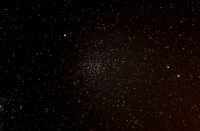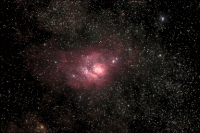The Chris Graham Robotic Telescope
May 2008
by Craig Breckenridge
Vancouver Centre CGRT Coordinator
Back in early 2005, an individual approached some of the executive of Vancouver Centre to see if there would be any interest in participating in a remote-telescope project. Needless to say, Council thought this would be an excellent project to bring the ability to work in new technologies to our membership. The initial planning meetings with Chris Graham, the equipment owner, and the interested Vancouver Centre members were held and an agreement in principle was worked out; Chris would provide the equipment and most of the software, and the RASCVC would provide some setup expertise, operation labour, and processing experience. It was a match that would evolve over time with both sides learning a great deal about remote-telescope operation.
 |
| Witch Head Nebula |
The initial setup was located in the New Mexico Skies compound on top of Mount Joy, near Cloudcroft, New Mexico. The site is at 7300´ elevation with latitude 32°54´ N and longitude 105°32´ W (Google Earth is high resolution in that area so it’s easy to pick out the domes). The 20-inch f8.1 RCOS Ritchey Chrétien telescope was on a Paramount MME, and controlled with TheSky, DC3 Dreams’ Astronomer’s Control Panel and DC3 Dream’s Scheduler. We used Maxim DL to control the original Apogee Alta U42 Back-thinned camera with an 8-position filter wheel. The whole telescope was housed in a 15-foot Technical Innovations Pro Dome that was controlled by Digital Dome Works. It wasn’t too long before the camera was changed to a SBIG 6303E with the AO7 adaptive-optics package.
 |
| NMS Equipment |
The observatory was set up and the learning curves worked through by a relatively small group who formed the CGRT Operations Committee.
 |
| M46 |
The setup was fairly complicated to start with and we had to overcome a large number of difficulties to understand the route required to make everything function as it should. We did struggle through it all and in the end we were able to script most of the operations so that it became quite simple to organize an observing session, perform the run, and transfer all the data. We had scripted dusk, dome, and dawn flats and were able to take hundreds of gigabytes of data each night. Transfer of the data from the NMS computer to our own FTP server was also scripted to happen during the daytime when bandwidth was not at a premium to operate the scopes. And then the bad weather came….
We struggled with bad weather for over a year, only able to operate the scope three or four times in the months from October through December 2007 as an example of the limited use. This was heartbreaking to say the least, and the rent for the compound was very expensive for the short time we could actually use the scope. When New Mexico Skies started up their Pingelly, Western Australia, operation in early September, Chris jumped at the opportunity and placed a great telescope in that facility as well. Setup of this new facility consumed the bad weather months in New Mexico and we were treated to southern skies and the wealth of new objects to observe. This led to some hard decisions on the part of equipment owner Chris, as operating two telescopes was a bit more then he could justify spending.
 |
| Omega Cluster |
The bad weather in New Mexico, combined with the rapid success of the Pingelly operation, brought about a rather substantial change in the CGRT program over the last couple of months. In January I advised the Vancouver Centre that Chris would be winding down the operations in New Mexico due to the rather unfavourable weather we have been experiencing over the last year. While this was a bit of a letdown, as we had just managed to learn the operation of Scheduler, the CGRT Committee felt that Chris was well justified as the scope was quite underutilized. We had mastered the issues that arose during normal operation, and if it wasn’t for the weather’s unpredictability we could have made the entire operation truly robotic and run only through scripts generated largely by Chris.
 |
| NGC 650 |
In the middle of February, Chris received an offer for the purchase of the entire operation in New Mexico that he couldn’t refuse. Since we had been planning to shut the scope down at the end of March, this was only a little earlier than originally planned. The Pingelly operation would be kept running, so the RASC still has access through the CGRT program to an excellent imaging system (more on this later).
 |
| Running Chicken Nebula |
The Pingelly site complements Vancouver weather-wise, with their worst observing during the time when we get our best, and vice versa. There is an added bonus in that we can operate the Pingelly telescope from about 3:00 a.m. to about 11:00 a.m. our time. No need to sit up all night to perform an observing run when you can do it over morning coffee!
The Pingelly telescope is an excellent wide-field instrument that has provided us with some great images already and we are just getting started. Operation of the scope is manual right now as there is a limit to the amount of bandwidth we can use from Western Australia. Pingelly is about 200 km southeast of Perth, and so is a bit of a rural area. The latitude and longitude are 32°31´ S and 117°05´ E. Unfortunately, Google Earth does not have very high resolution in the area. While we could easily run the scope with the scripts developed for New Mexico, we don’t have enough bandwidth to transmit the amount of data that results to our FTP server. Remember that each image is over 12 MB, and that doesn’t change regardless of exposure time. A single colour image takes a luminance exposure, red exposure, blue exposure, and green exposure. This adds up to over 48 MB, and that doesn’t count the required darks, biases, and flats!
 |
| M8 |
The Pingelly telescope is housed in a Pod. This means we no longer have to worry about controlling a dome. The telescope is a Takahashi Epsilon 210 and is mounted on a Paramount MME German Equatorial Mount. Currently we are using a SBIG STL-6303E Class 1 camera (2k x 3k 9-micron pixels) and a SBIG 5-position filter wheel with R, G, B, L, and Hα filters installed. Chris is contemplating changing the camera to a SBIG ST-4000XCM (2k x 2k pixels), but hasn’t made that decision yet.
 |
| Equipment |
We are controlling the scope with TheSky 6 and the camera with Maxim DL. We have DC3 Dreams’ Astronomer’s Control Panel and DC3 Dreams’ Scheduler installed, and will use them once the bandwidth improves. The whole thing runs on a HP XP4300 Dual Core P4 workstation, and we use Radmin Remote Desktop to access it.
 |
| LMC |
Data for images are downloaded from Pingelly to either our Windows computer or our Linux FTP server — both located at Simon Fraser University (SFU). Members can access the data there by requesting access from the CGRT Committee. In the very near future we will be transferring data from the SFU computers to the Canadian Astronomical Database Centre at the Hertzberg Institute for Astrophysics (located at the Dominion Astrophysical Observatory on Vancouver Island) as soon as we finalize the transfer scripts. They will become available to the public and all RASC members once that happens. All flats, bias, and dark frames will also be kept current at the CADC so that members and the public can try their hand at processing images.
All the images that accompany the article are 30-seconds or less exposure. Processing has been by Chris Graham, Wayne Lyons, Bob Parry, or Craig Breckenridge. These are just quickly processed images; we have several hundred GB of images available for processing by members if they choose.
 |
| eta Carina |
All RASC members are invited to participate in the project by joining the CGRT forum at www.cgrt.ca, where we have a Wiki, a forum for discussion, an event calendar to book time on the scope (operation of the scope is limited to Vancouver Centre members at the present time — this may be opened up later once full robotic operation is possible again). A photo gallery is in the works and is partially set up at this time. All members of the RASC across Canada may request imaging runs be performed on their behalf by contacting the CGRT Committee either through the Web site or via email to Vancouver Centre Council. Any member that wants to try their hand at processing any of the data already on hand can get access to the CGRT FTP server by contacting the CGRT Committee. We have on hand about 300 GB of unprocessed data, including almost all the Messier objects in both colour and black and white.
| Attachment | Size |
|---|---|
| 10.28 KB | |
| 20.82 KB | |
| 14.42 KB | |
| 7.49 KB | |
| 15.38 KB | |
| 11.32 KB | |
| 15.92 KB | |
| 18.14 KB | |
| 20.96 KB | |
| 13.09 KB |
